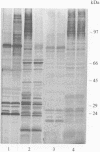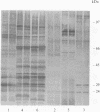Abstract
Ciprofloxacin was used as empirical therapy for peritonitis in patients receiving continuous ambulatory peritoneal dialysis (CAPD) for 26 months, providing an opportunity to study the epidemiology of ciprofloxacin resistance amongst coagulase-negative staphylococci (CNS). Swabs were collected from the CAPD patients, staff, and clinic environment before, during and after the time this antibiotic was prescribed. Clinical isolates were also studied, and records kept of patient hospital attendance. Ciprofloxacin-resistant staphylococci were typed by antibiogram, biotype, plasmid profile, SDS-PAGE, and immunoblotting. No resistant strains were detected before the use of ciprofloxacin. During its use 30% of patients became skin carriers, and resistant strains caused 8% of peritonitis episodes in 7% of patients (38% of carriers). Resistant strains were isolated from the environment, but never from attending members of staff. A total of 208 resistant isolates with MIC's between 8 and 128 mg/l was collected and identified as Staphylococcus epidermidis or S. haemolyticus. Sixteen strain types were distinguished. There was epidemiological evidence for selection of resistant strains derived from the host commensal flora and also for cross-colonization, and cross-infection. Carriage of resistant strains fell to 15% of patients, 6 months after the use of ciprofloxacin had ceased.
Full text
PDF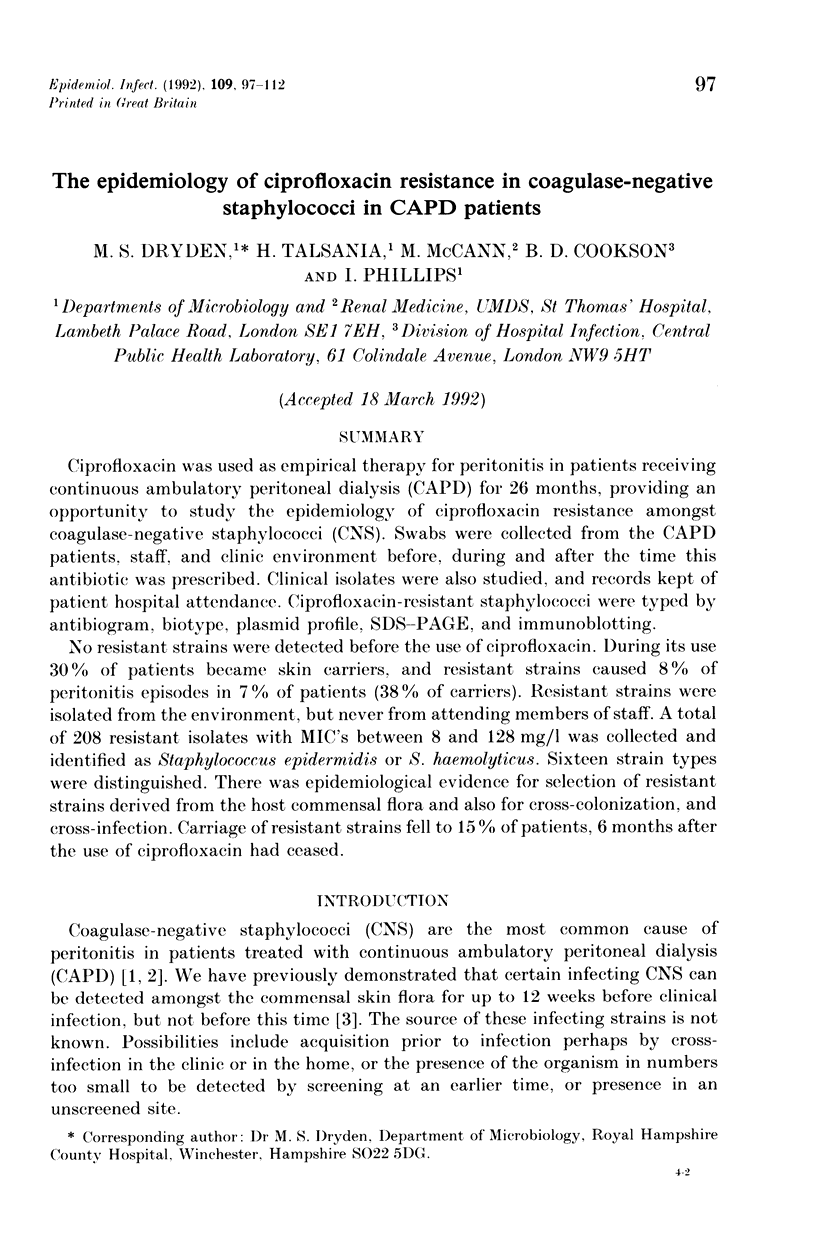
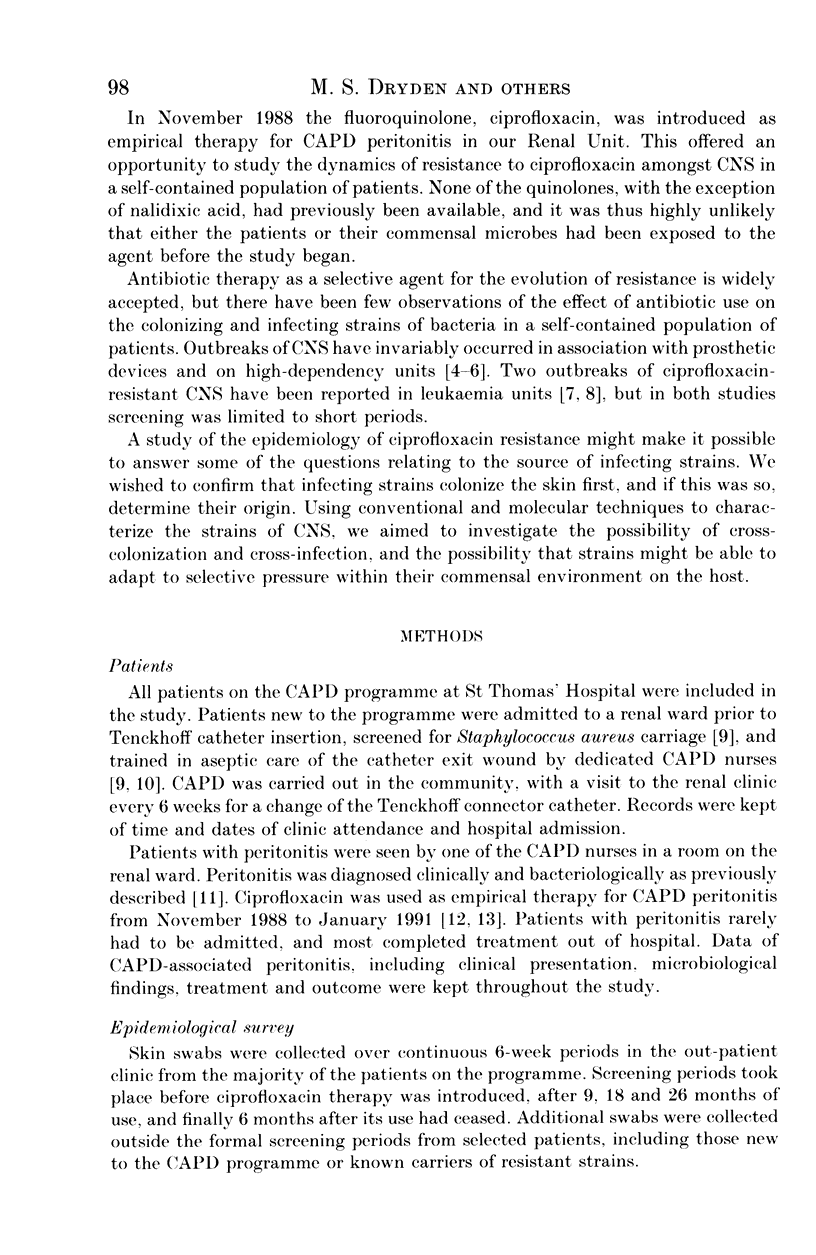
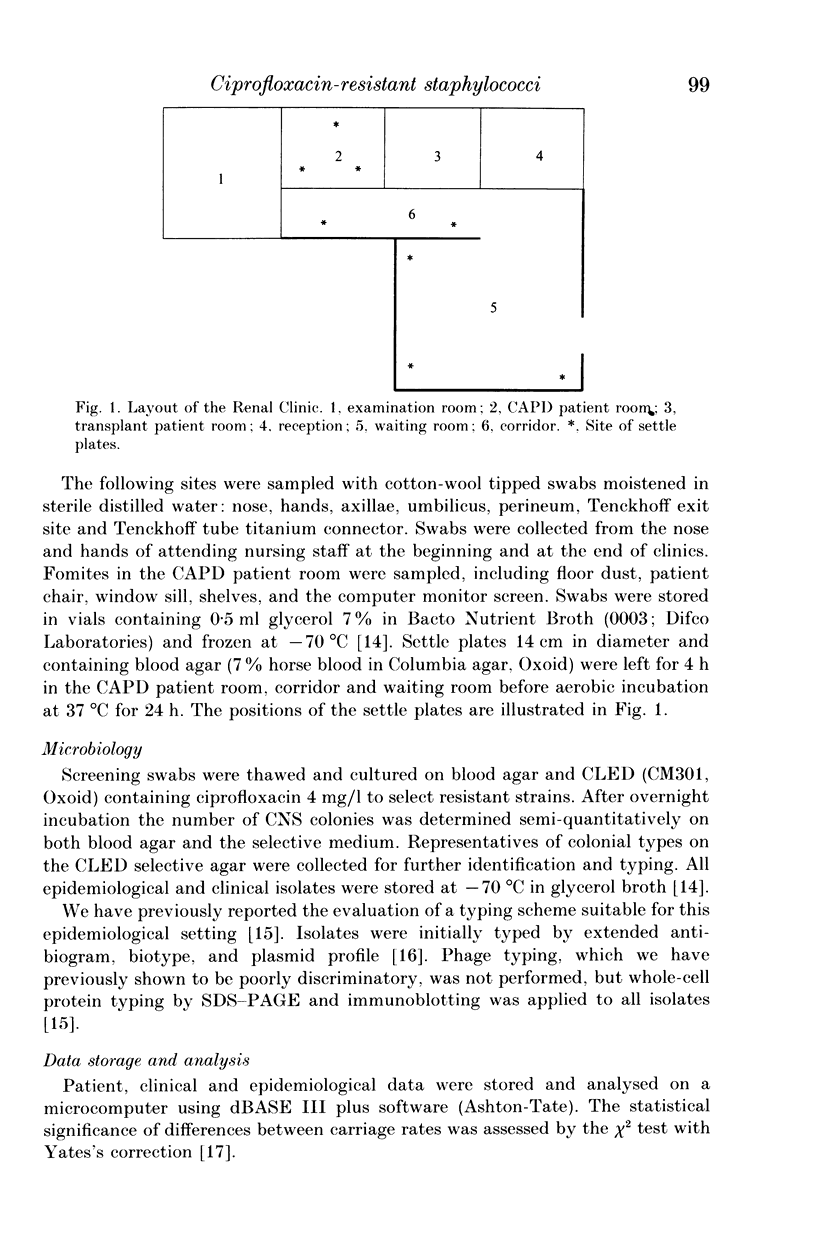


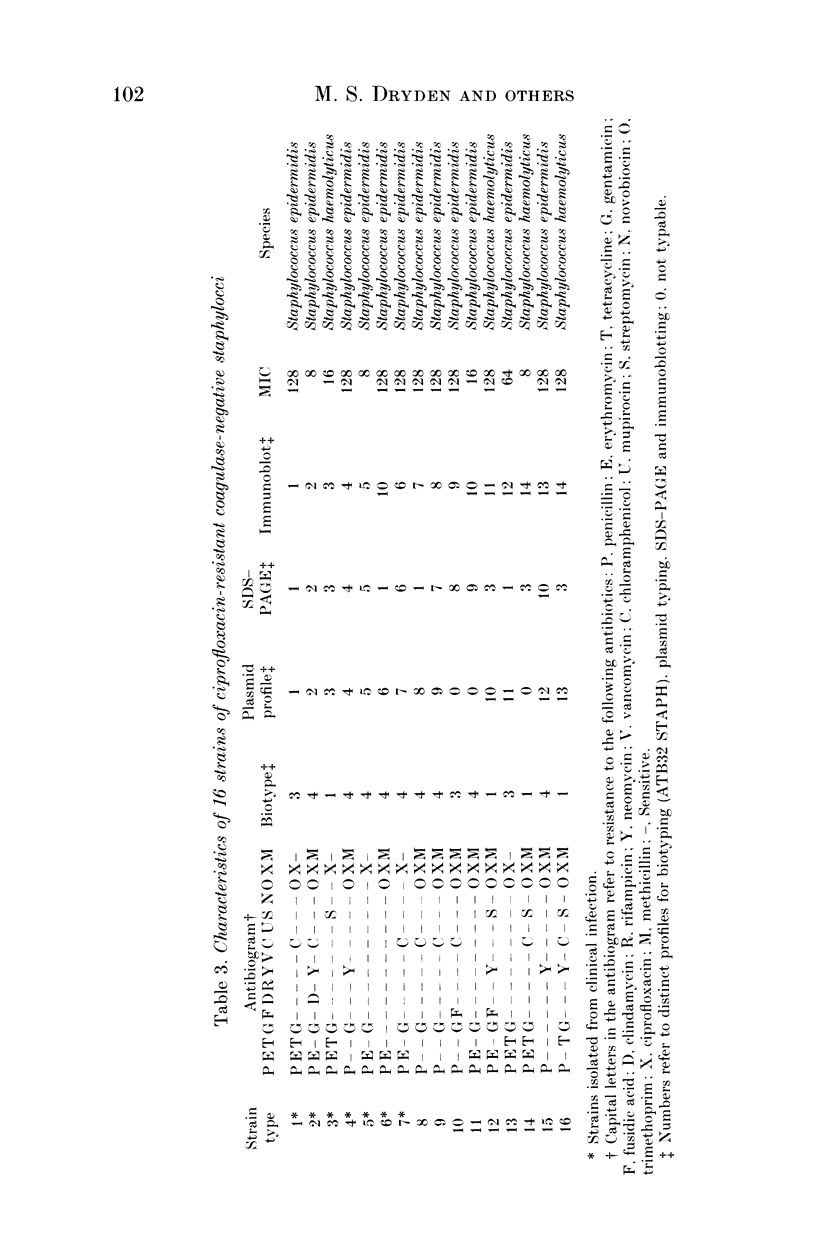
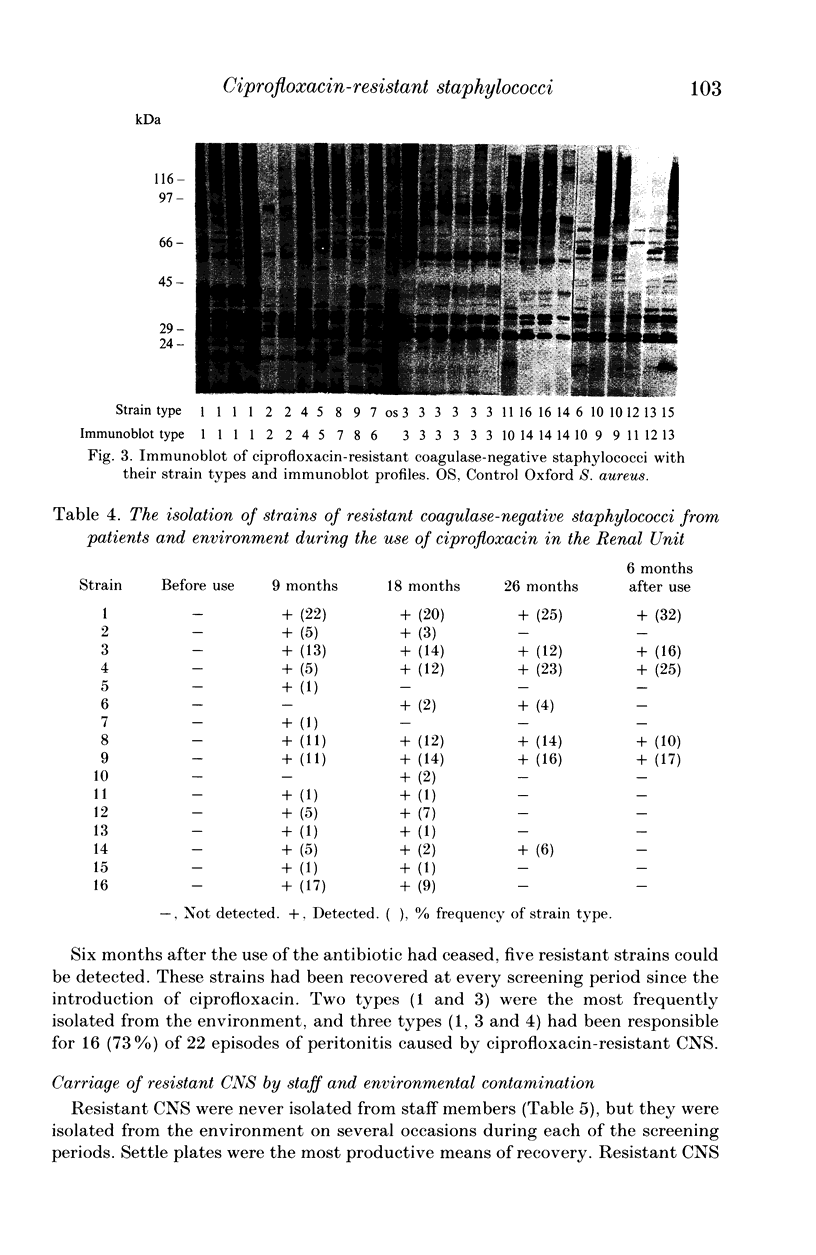
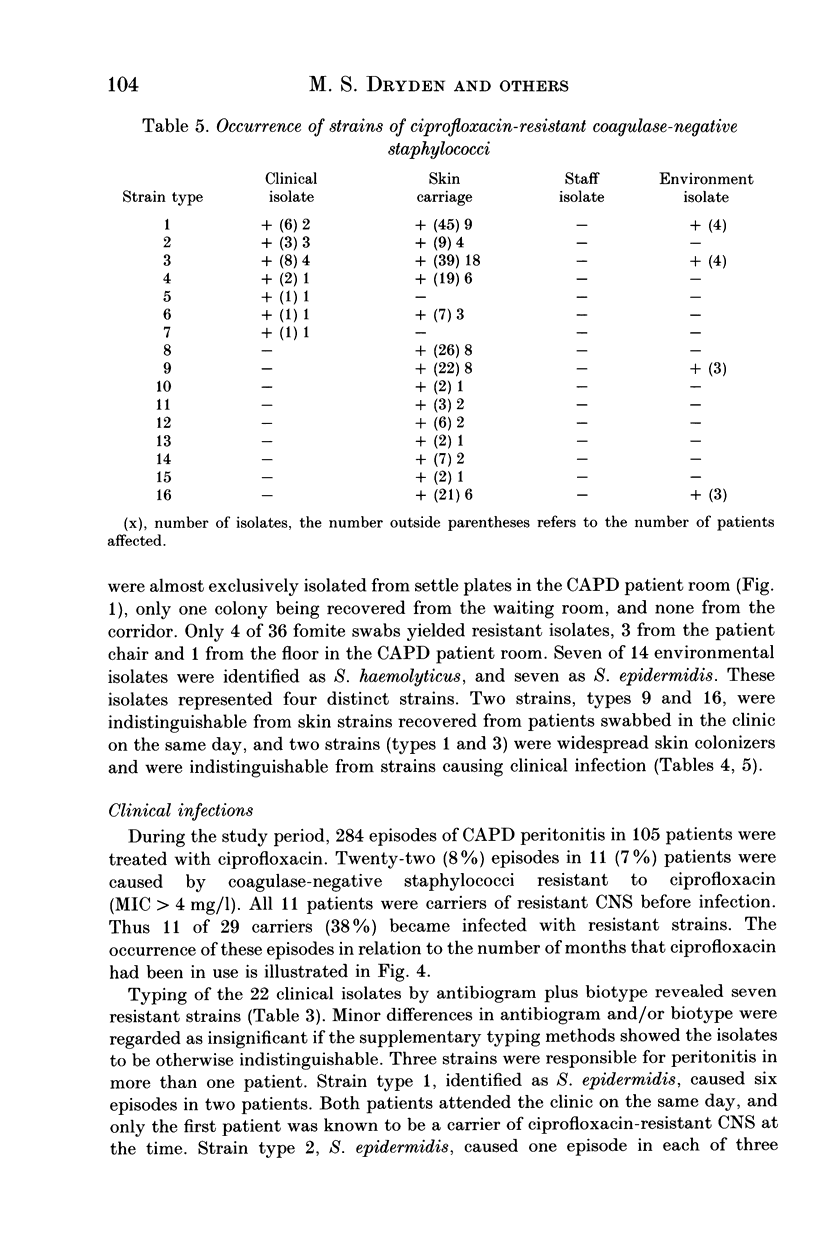
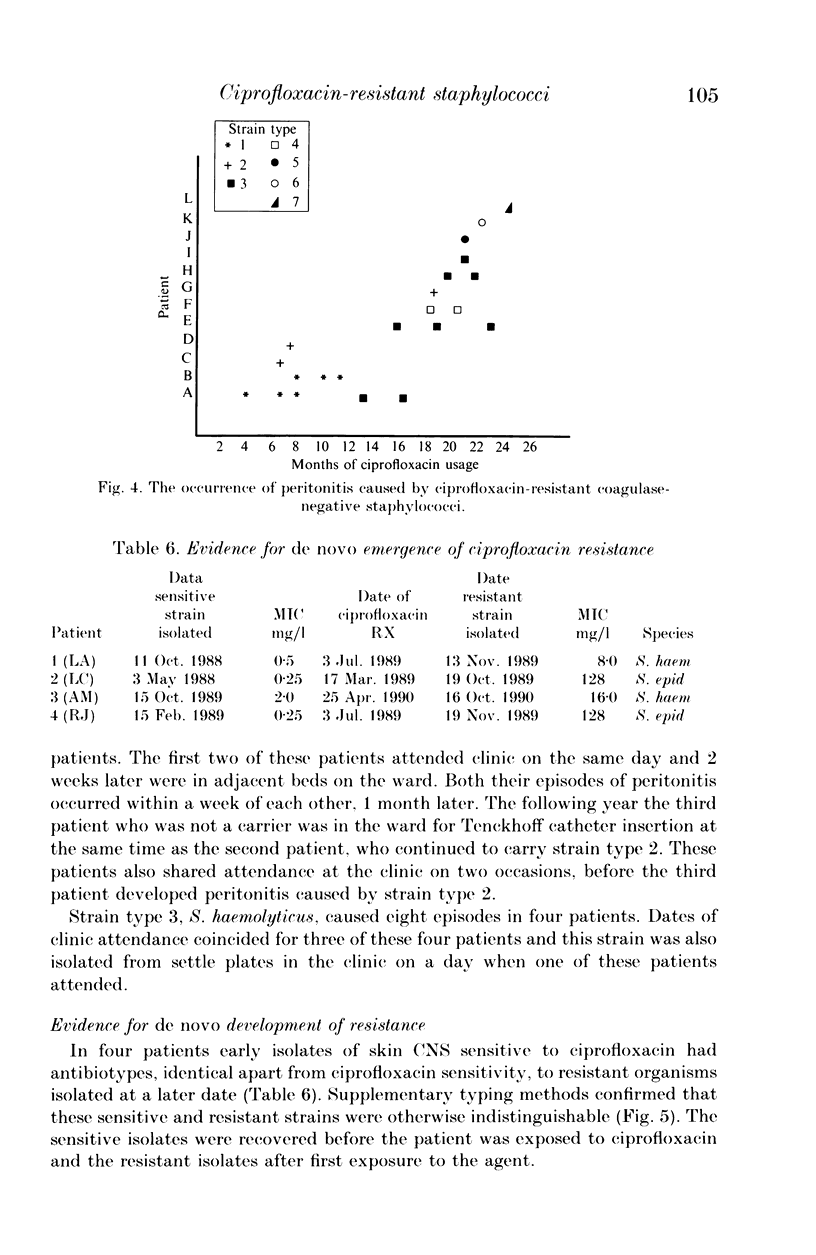
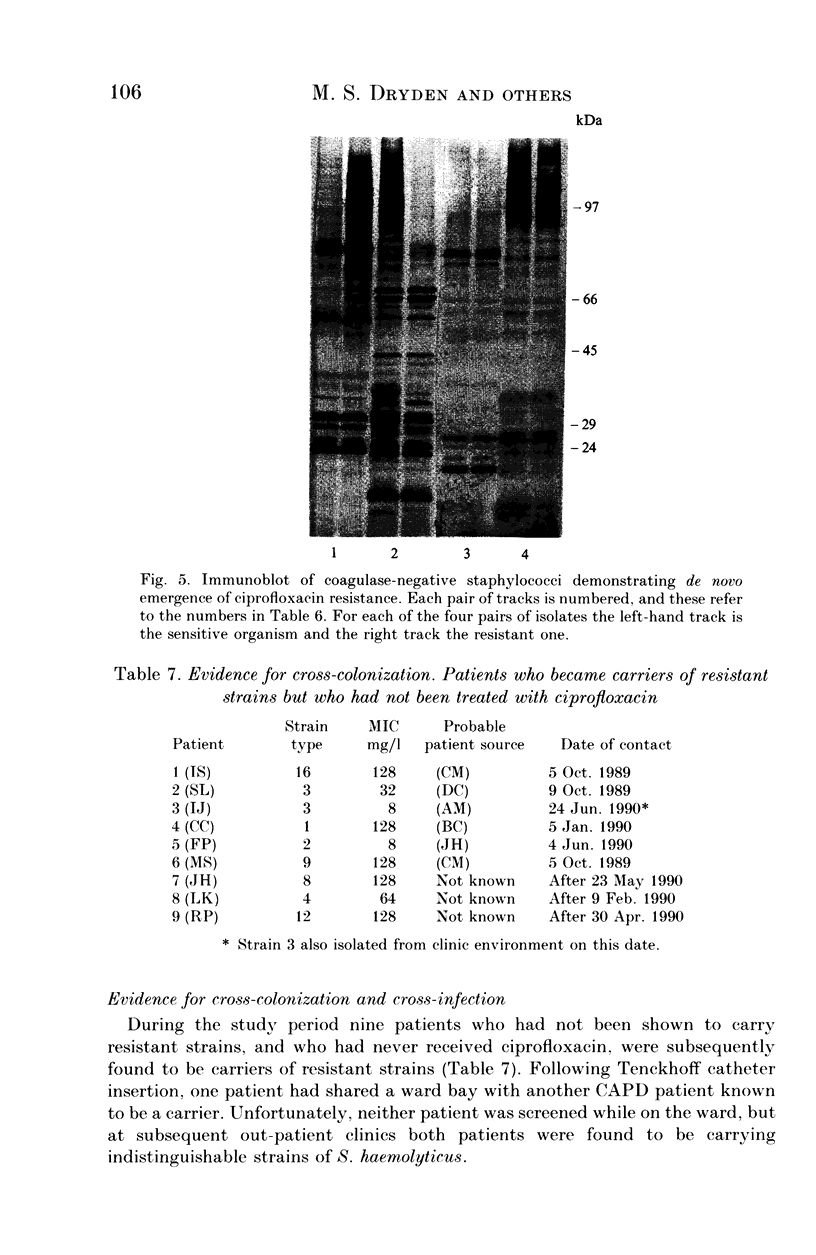
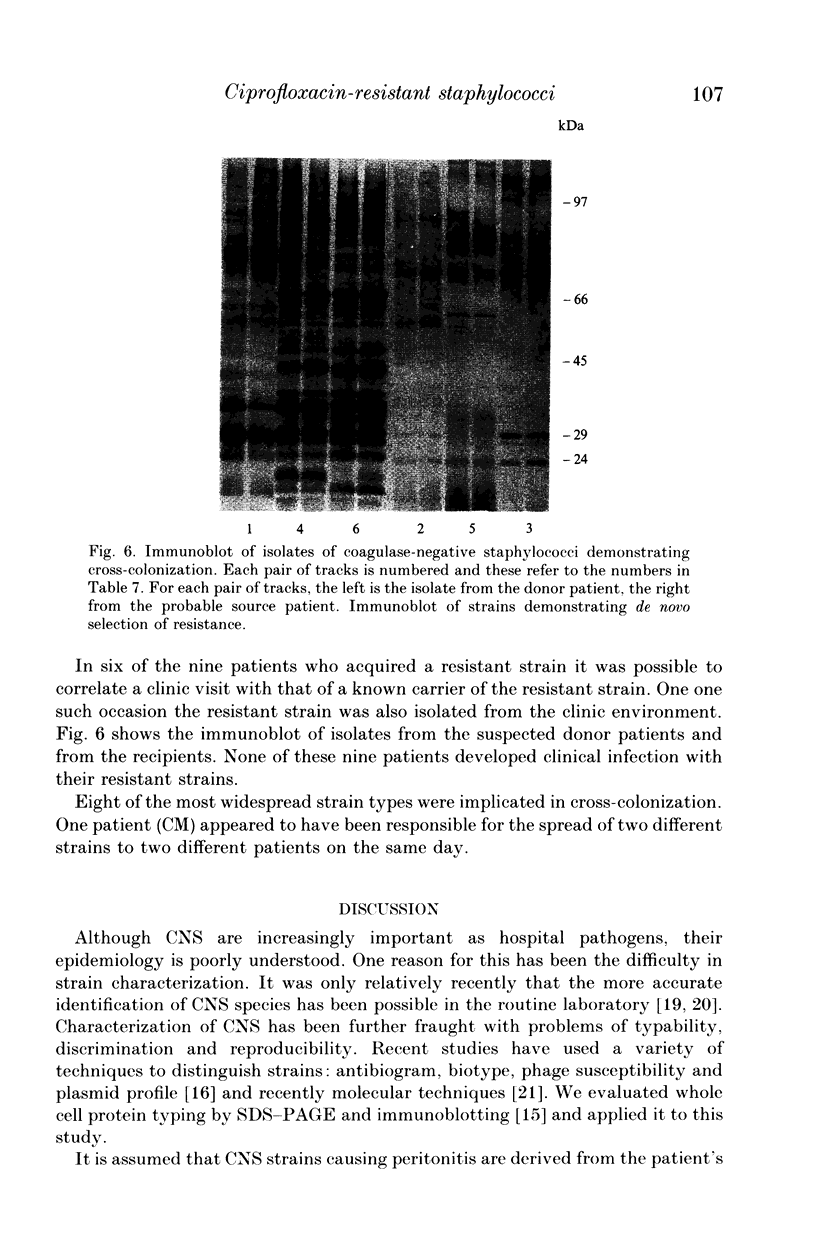

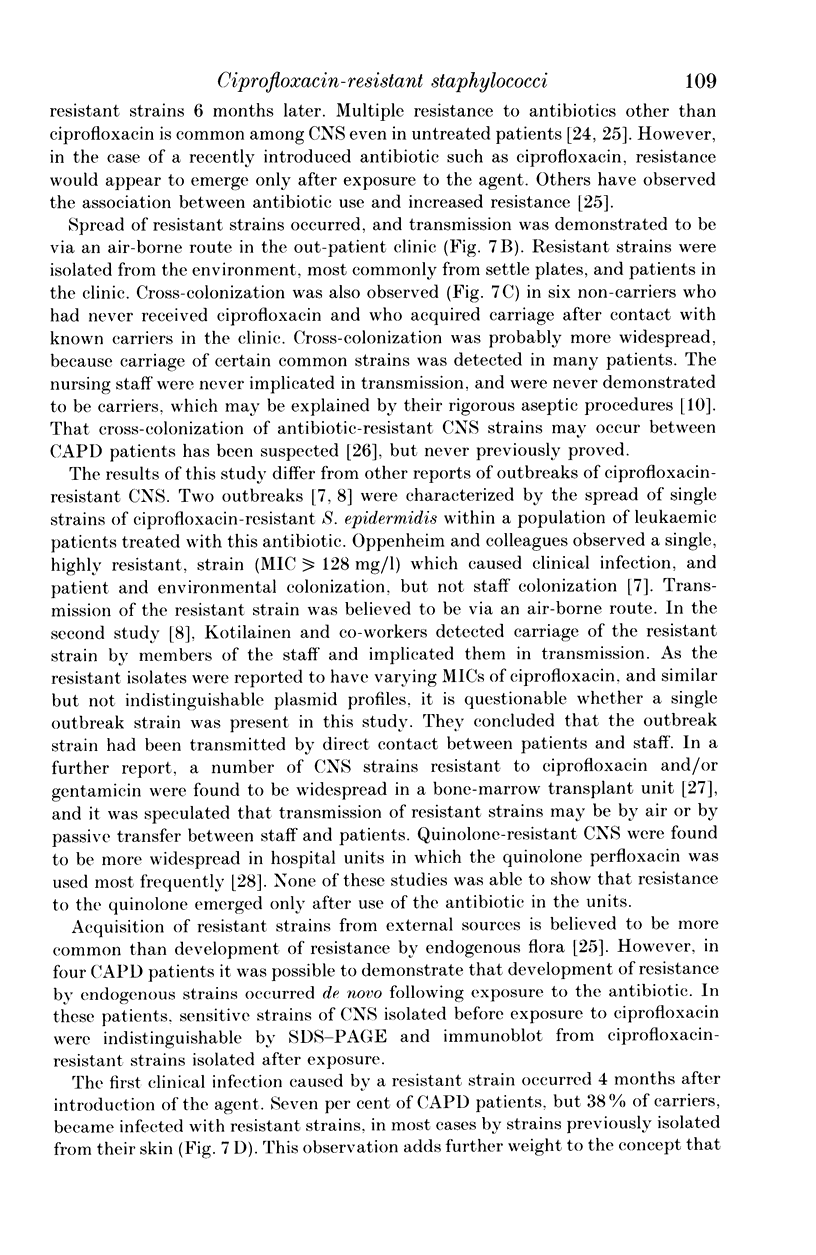
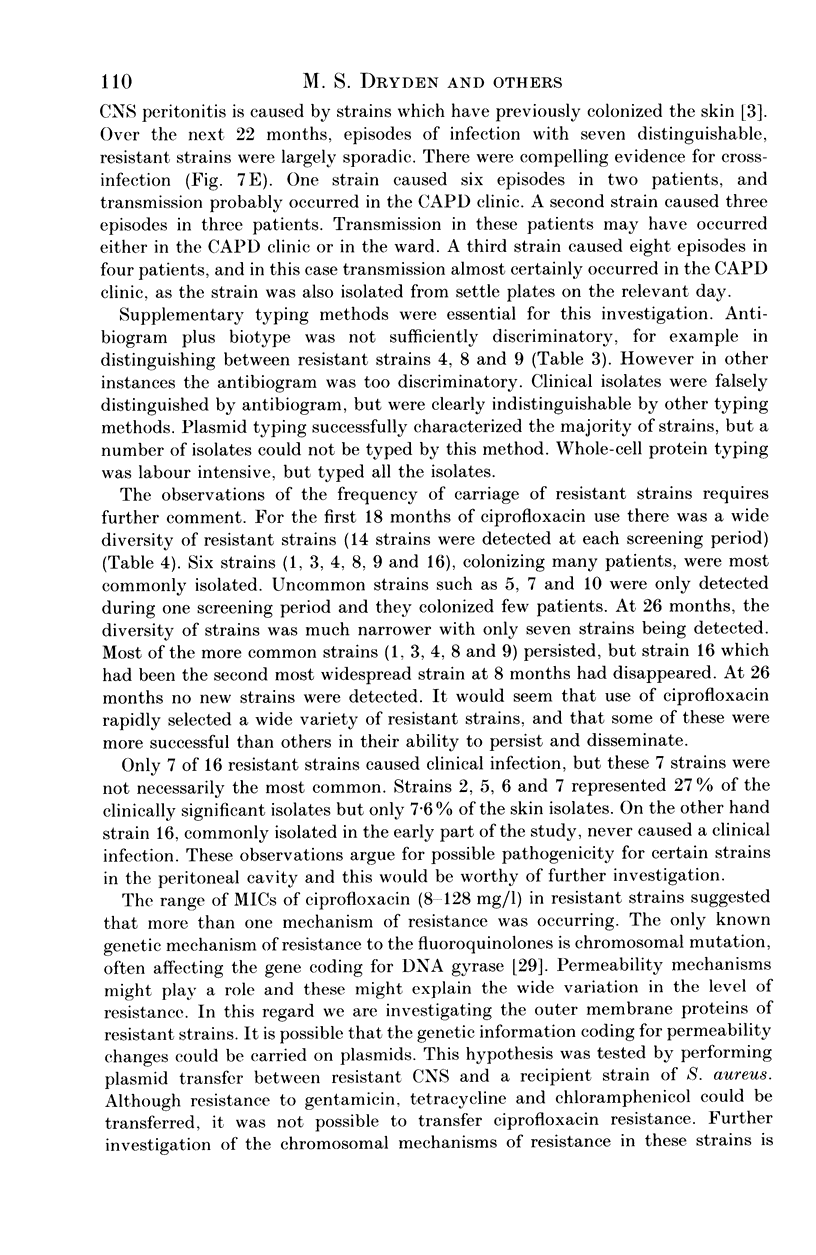
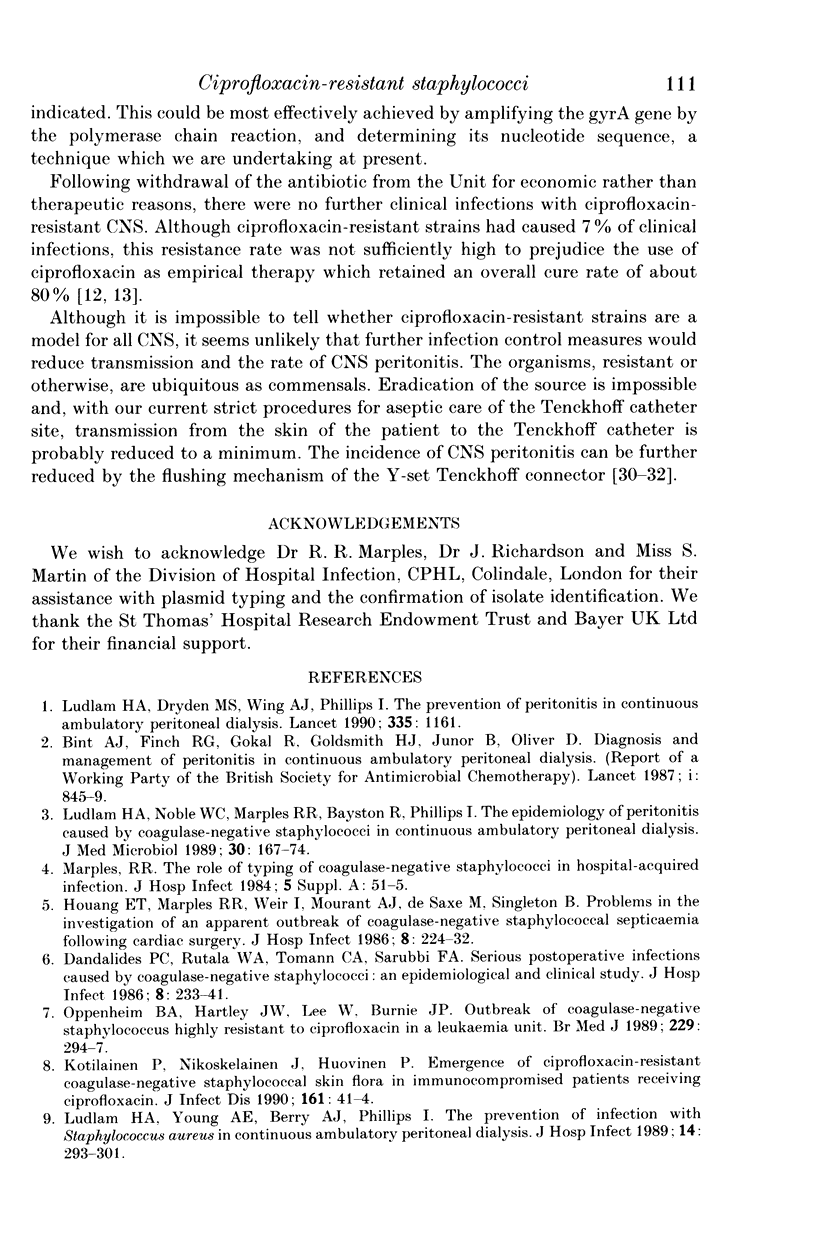
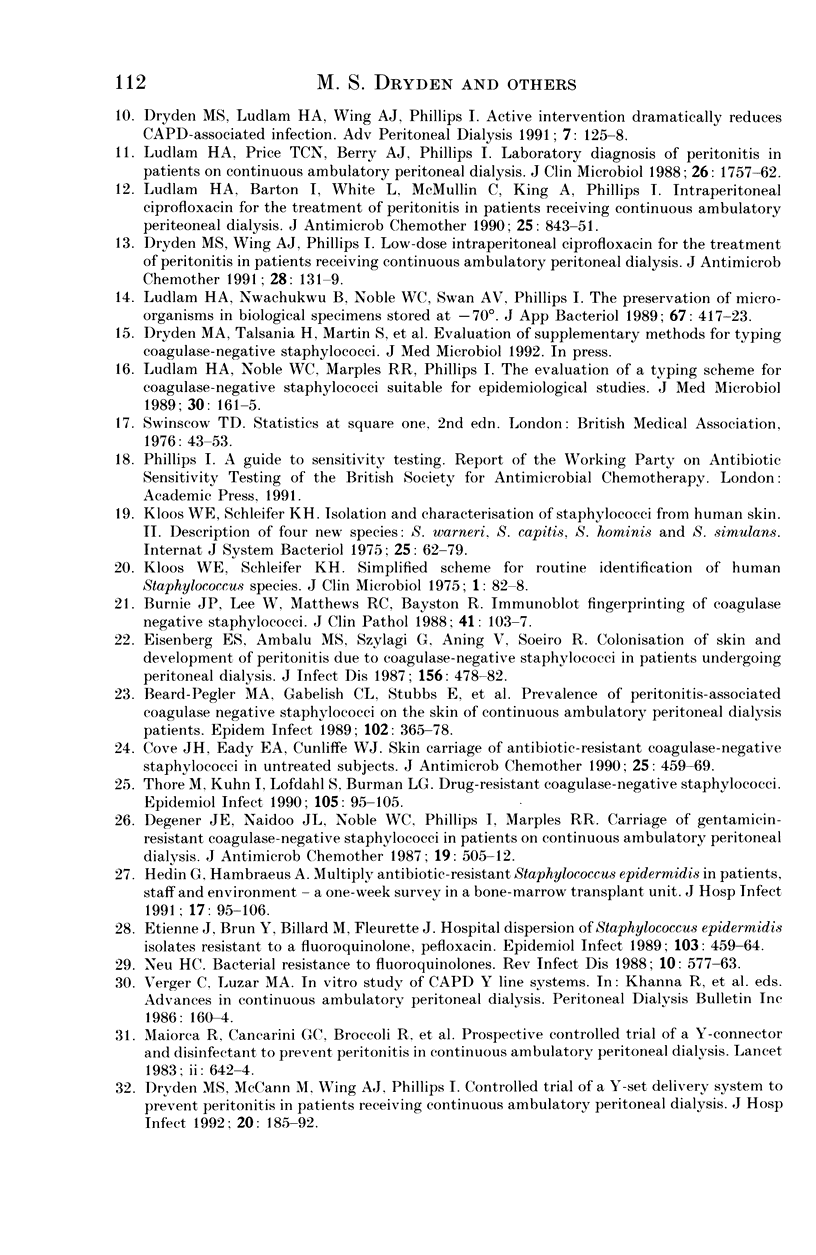
Images in this article
Selected References
These references are in PubMed. This may not be the complete list of references from this article.
- Beard-Pegler M. A., Gabelish C. L., Stubbs E., Harbour C., Robson J., Falk M., Benn R., Vickery A. Prevalence of peritonitis-associated coagulase-negative staphylococci on the skin of continuous ambulatory peritoneal dialysis patients. Epidemiol Infect. 1989 Jun;102(3):365–378. doi: 10.1017/s0950268800030089. [DOI] [PMC free article] [PubMed] [Google Scholar]
- Burnie J. P., Lee W., Matthews R. C., Bayston R. Immunoblot fingerprinting of coagulase negative staphylococci. J Clin Pathol. 1988 Jan;41(1):103–107. doi: 10.1136/jcp.41.1.103. [DOI] [PMC free article] [PubMed] [Google Scholar]
- Cove J. H., Eady E. A., Cunliffe W. J. Skin carriage of antibiotic-resistant coagulase-negative staphylococci in untreated subjects. J Antimicrob Chemother. 1990 Mar;25(3):459–469. doi: 10.1093/jac/25.3.459. [DOI] [PubMed] [Google Scholar]
- Dandalides P. C., Rutala W. A., Thomann C. A., Sarubbi F. A. Serious postoperative infections caused by coagulase-negative staphylococci: an epidemiological and clinical study. J Hosp Infect. 1986 Nov;8(3):233–241. doi: 10.1016/0195-6701(86)90118-0. [DOI] [PubMed] [Google Scholar]
- Degener J. E., Naidoo J. L., Noble W. C., Phillips I., Marples R. R. Carriage of gentamicin-resistant coagulase-negative staphylococci in patients on continuous ambulatory peritoneal dialysis. J Antimicrob Chemother. 1987 Apr;19(4):505–512. doi: 10.1093/jac/19.4.505. [DOI] [PubMed] [Google Scholar]
- Diagnosis and management of peritonitis in continuous ambulatory peritoneal dialysis. Report of a working party of the British Society for Antimicrobial Chemotherapy. Lancet. 1987 Apr 11;1(8537):845–849. [PubMed] [Google Scholar]
- Dryden M. S., Ludlam H. A., Wing A. J., Phillips I. Active intervention dramatically reduces CAPD-associated infection. Adv Perit Dial. 1991;7:125–128. [PubMed] [Google Scholar]
- Dryden M. S., McCann M., Wing A. J., Phillips I. Controlled trial of a Y-set dialysis delivery system to prevent peritonitis in patients receiving continuous ambulatory peritoneal dialysis. J Hosp Infect. 1992 Mar;20(3):185–192. doi: 10.1016/0195-6701(92)90086-2. [DOI] [PubMed] [Google Scholar]
- Dryden M. S., Wing A. J., Phillips I. Low dose intraperitoneal ciprofloxacin for the treatment of peritonitis in patients receiving continuous ambulatory peritoneal dialysis (CAPD). J Antimicrob Chemother. 1991 Jul;28(1):131–139. doi: 10.1093/jac/28.1.131. [DOI] [PubMed] [Google Scholar]
- Eisenberg E. S., Ambalu M., Szylagi G., Aning V., Soeiro R. Colonization of skin and development of peritonitis due to coagulase-negative staphylococci in patients undergoing peritoneal dialysis. J Infect Dis. 1987 Sep;156(3):478–482. doi: 10.1093/infdis/156.3.478. [DOI] [PubMed] [Google Scholar]
- Etienne J., Brun Y., Billard M., Fleurette J. Hospital dispersion of Staphylococcus epidermidis isolates resistant to a fluoroquinolone, pefloxacin. Epidemiol Infect. 1989 Dec;103(3):459–464. doi: 10.1017/s0950268800030867. [DOI] [PMC free article] [PubMed] [Google Scholar]
- Hedin G., Hambraeus A. Multiply antibiotic-resistant Staphylococcus epidermidis in patients, staff and environment--a one-week survey in a bone marrow transplant unit. J Hosp Infect. 1991 Feb;17(2):95–106. doi: 10.1016/0195-6701(91)90173-6. [DOI] [PubMed] [Google Scholar]
- Houang E. T., Marples R. R., Weir I., Mourant A. J., de Saxe M. J., Singleton B. Problems in the investigation of an apparent outbreak of coagulase-negative staphylococcal septicaemia following cardiac surgery. J Hosp Infect. 1986 Nov;8(3):224–232. doi: 10.1016/0195-6701(86)90117-9. [DOI] [PubMed] [Google Scholar]
- Kloos W. E., Schleifer K. H. Simplified scheme for routine identification of human Staphylococcus species. J Clin Microbiol. 1975 Jan;1(1):82–88. doi: 10.1128/jcm.1.1.82-88.1975. [DOI] [PMC free article] [PubMed] [Google Scholar]
- Kotilainen P., Nikoskelainen J., Huovinen P. Emergence of ciprofloxacin-resistant coagulase-negative staphylococcal skin flora in immunocompromised patients receiving ciprofloxacin. J Infect Dis. 1990 Jan;161(1):41–44. doi: 10.1093/infdis/161.1.41. [DOI] [PubMed] [Google Scholar]
- Ludlam H. A., Barton I., White L., McMullin C., King A., Phillips I. Intraperitoneal ciprofloxacin for the treatment of peritonitis in patients receiving continuous ambulatory peritoneal dialysis (CAPD). J Antimicrob Chemother. 1990 May;25(5):843–851. doi: 10.1093/jac/25.5.843. [DOI] [PubMed] [Google Scholar]
- Ludlam H. A., Noble W. C., Marples R. R., Bayston R., Phillips I. The epidemiology of peritonitis caused by coagulase-negative staphylococci in continuous ambulatory peritoneal dialysis. J Med Microbiol. 1989 Nov;30(3):167–174. doi: 10.1099/00222615-30-3-167. [DOI] [PubMed] [Google Scholar]
- Ludlam H. A., Noble W. C., Marples R. R., Phillips I. The evaluation of a typing scheme for coagulase-negative staphylococci suitable for epidemiological studies. J Med Microbiol. 1989 Nov;30(3):161–165. doi: 10.1099/00222615-30-3-161. [DOI] [PubMed] [Google Scholar]
- Ludlam H. A., Nwachukwu B., Noble W. C., Swan A. V., Phillips I. The preservation of micro-organisms in biological specimens stored at-70 degrees C. J Appl Bacteriol. 1989 Oct;67(4):417–423. doi: 10.1111/j.1365-2672.1989.tb02512.x. [DOI] [PubMed] [Google Scholar]
- Ludlam H. A., Price T. N., Berry A. J., Phillips I. Laboratory diagnosis of peritonitis in patients on continuous ambulatory peritoneal dialysis. J Clin Microbiol. 1988 Sep;26(9):1757–1762. doi: 10.1128/jcm.26.9.1757-1762.1988. [DOI] [PMC free article] [PubMed] [Google Scholar]
- Ludlam H. A., Young A. E., Berry A. J., Phillips I. The prevention of infection with Staphylococcus aureus in continuous ambulatory peritoneal dialysis. J Hosp Infect. 1989 Nov;14(4):293–301. doi: 10.1016/0195-6701(89)90069-8. [DOI] [PubMed] [Google Scholar]
- Ludlam H., Dryden M., Wing A. J., Phillips I. Prevention of peritonitis in continuous ambulatory peritoneal dialysis. Lancet. 1990 May 12;335(8698):1161–1161. doi: 10.1016/0140-6736(90)91164-6. [DOI] [PubMed] [Google Scholar]
- Maiorca R., Cantaluppi A., Cancarini G. C., Scalamogna A., Broccoli R., Graziani G., Brasa S., Ponticelli C. Prospective controlled trial of a Y-connector and disinfectant to prevent peritonitis in continuous ambulatory peritoneal dialysis. Lancet. 1983 Sep 17;2(8351):642–644. doi: 10.1016/s0140-6736(83)92528-x. [DOI] [PubMed] [Google Scholar]
- Oppenheim B. A., Hartley J. W., Lee W., Burnie J. P. Outbreak of coagulase negative staphylococcus highly resistant to ciprofloxacin in a leukaemia unit. BMJ. 1989 Jul 29;299(6694):294–297. doi: 10.1136/bmj.299.6694.294. [DOI] [PMC free article] [PubMed] [Google Scholar]
- Thore M., Kühn I., Löfdahl S., Burman L. G. Drug-resistant coagulase-negative skin staphylococci. Evaluation of four marker systems and epidemiology in an orthopaedic ward. Epidemiol Infect. 1990 Aug;105(1):95–105. doi: 10.1017/s0950268800047695. [DOI] [PMC free article] [PubMed] [Google Scholar]




